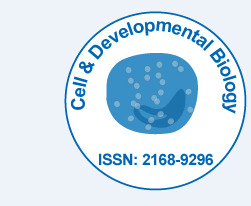
Cell & Developmental Biology
Open Access
ISSN: 2168-9296

ISSN: 2168-9296
Opinion Article - (2025)Volume 14, Issue 1
Mechanical forces play fundamental roles in shaping developing embryos, driving tissue morphogenesis through complex mechanotransduction pathways that convert physical stimuli into biochemical signals. The integration of mechanical cues with genetic programs orchestrates the precise spatial and temporal organization of developing tissues, from the initial establishment of body axes to the formation of complex organ systems. Recent advances in biophysical techniques and computational modeling have revealed the sophisticated mechanisms by which cells sense, respond to, and generate mechanical forces during embryogenesis.
The cellular machinery responsible for mechanotransduction involves multiple interconnected systems, including the cytoskeleton, cell adhesion complexes, and mechanosensitive ion channels. Actin filaments, microtubules, and intermediate filaments form the structural framework that transmits mechanical forces across cells and tissues. Myosin motor proteins generate contractile forces that drive tissue deformation, while the dynamic reorganization of cytoskeletal networks enables cellular responses to external mechanical stimuli. The mechanosensitive properties of these cytoskeletal elements create a responsive system capable of both force generation and force sensing.
Adherens junctions and tight junctions serve as key mechanotransduction sites where mechanical forces are transmitted between neighboring cells. The cadherin-catenin complex at adherens junctions directly links the actin cytoskeleton of adjacent cells, creating a mechanically coupled tissue-wide network. Force application to these junctions triggers conformational changes in constituent proteins, exposing cryptic binding sites and altering protein-protein interactions. This mechanical regulation of molecular interactions provides a direct mechanism for force-dependent signaling cascades that influence gene expression and cell behavior.
Focal adhesions represent critical mechanotransduction sites where cells interact with the extracellular matrix. These dynamic structures contain numerous mechanosensitive proteins, including talin, vinculin, and Focal Adhesion Kinase (FAK), which undergo conformational changes in response to applied forces. The mechanical unfolding of these proteins reveals additional binding sites and catalytic domains, amplifying the cellular response to mechanical stimuli. The size and composition of focal adhesions scale with applied forces, creating a dynamic system that adapts to changing mechanical environments.
Mechanosensitive ion channels provide rapid mechanotransduction responses by directly converting mechanical forces into electrical signals. Piezo1 and Piezo2 channels respond to membrane tension and mechanical deformation, generating calcium influx that activates downstream signaling pathways. These channels play essential roles in various developmental processes, including vascular development, neural tube closure, and sensory organ formation. The spatial distribution and activity of mechanosensitive channels create patterns of cellular excitation that coordinate tissue-wide responses to mechanical stimuli.
The Hippo signaling pathway represents a key mechanotransduction network that regulates organ size and tissue homeostasis. Transcriptional coactivators serve as mechanosensitive effectors that translocate to the nucleus in response to mechanical forces, promoting the expression of proliferation and survival genes. The subcellular localization Transcriptional coactivators depends on multiple mechanical inputs, including cell density, substrate stiffness, and cytoskeletal tension. This pathway integrates mechanical information with growth control mechanisms, ensuring appropriate tissue size during development.
Tissue-scale mechanical forces emerge from the collective behavior of individual cells and drive large-scale morphogenetic movements. Convergent extension movements elongate tissue axes through coordinated cell intercalation driven by planar cell polarity signaling. Neural tube closure involves the generation of hinge points where localized cell constriction creates tissue folding. Gastrulation movements are powered by coordinated changes in cell shape and adhesion that drive the internalization of mesoderm and endoderm. These morphogenetic processes require the precise coordination of mechanical forces across multiple length scales, from molecular interactions to tissuewide deformations.
Mechanotransduction represents a fundamental mechanism by which physical forces guide embryonic development, integrating mechanical information with genetic programs to orchestrate tissue morphogenesis. The multi-scale nature of mechanotransduction, from molecular conformational changes to tissue-wide force patterns, enables the precise control of developmental processes. Understanding these mechanobiological principles has important implications for regenerative medicine, tissue engineering, and the development of therapeutic strategies for developmental disorders. Future research should focus on quantifying the mechanical properties of developing tissues and developing predictive models that integrate mechanical and biochemical signaling networks.
Citation: Gilani R (2025). Mechanotransduction in Tissue Morphogenesis during Embryonic Development. Cell Dev Biol. 14:381.
Received: 28-Feb-2025, Manuscript No. CDB-25-38147; Editor assigned: 03-Mar-2025, Pre QC No. CDB-25-38147 (PQ); Reviewed: 17-Mar-2025, QC No. CDB-25-38147; Revised: 24-Mar-2025, Manuscript No. CDB-25-38147 (R); Published: 31-Mar-2025 , DOI: 10.35248/2168-9296.25.14.381
Copyright: © 2025 Gilani R. This is an open-access article distributed under the terms of the Creative Commons Attribution License, which permits unrestricted use, distribution, and reproduction in any medium, provided the original author and source are credited.